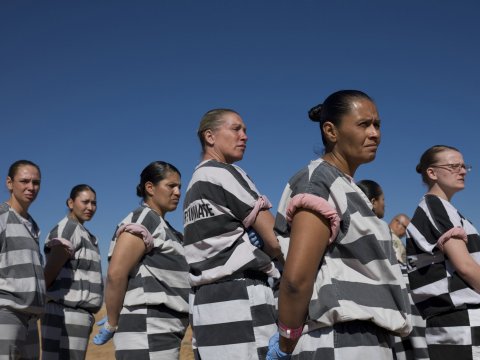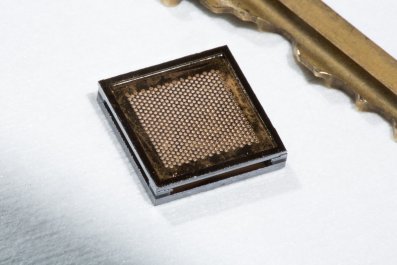In 2006, the Utah Department of Corrections (DOC) decided it had to do something about the female inmates in its facilities. The women were unruly and anxious, often refusing to comply with regulations and occasionally acting violently. The guards took a rare step back, thought for a second and came up with a theory. The female inmates might be feeling dehumanized—and acting accordingly—because of their clothes.
The guards noted how many of the women's feet were slipping around in shoes three sizes too large, and how their sanitary pads could be seen through the near-translucent fabric of their uniforms. "A male's white uniform doesn't do much for [a woman's] self-respect," Jack Ford, a DOC spokesman, told The Salt Lake Tribune.
So the DOC made some changes. The women were given brand-new uniforms the color of plum wine. The prison lifted its ban on cosmetics, and the inmates picked out lip colors, eye shadows and blushes. Maybe a lot of this sounds too gender normative for the 21st century, but it seemed to work: Disciplinary problems plummeted. That's because, thanks to their new uniforms, the women inmates no longer see themselves as prisoners but as people. The clothes they wear have altered how they perceive themselves, and the world.
Earlier this year, cognitive psychologist Abraham Rutchick was sitting in on a surgery and needed to take a break to go to the bathroom. While washing his hands, Rutchick stared at his reflection in the mirror, his eyes lighting upon the surgical scrubs he'd borrowed from the hospital in order to enter the ER. "I'm looking at them in the bathroom, and I'm realizing, These pants are the most comfortable pants I've ever worn in my entire life," Rutchick says.
But it wasn't just that his legs felt comfy in cotton—he felt the scrubs had put him into a looser state of mind. Which sounds a little crazy, but he had just done the research to back it up. Several months before, in 2015, Rutchick had led a study to determine exactly how clothing choices can affect a person's mental state. His team found that when participants donned expensive, tailored suits, they were more likely to forgo a $12 reward that day in order to receive a $20 reward a day later. The researchers argued that these participants were demonstrating better abstract processing, the kind of big-picture thinking CEOs and managers are required to perform on a regular basis.
"We do see people, when they wear formal clothing, shift toward long-term planning," says Rutchick. On the flip side, participants who wore clothing typically associated with lower-status positions demonstrated greater levels of "machine" thinking, the kind required to perform basic duties more efficiently. That's why in many cases, institutional management will encourage executives to wear power suits while giving mailroom employees name-tagged uniforms. "If you're in an organization, you want some people to come up with big ideas, and you want other people to carry them out."
Rutchick is at the forefront of a field of study called "enclothed cognition." The theory is that clothes really do make the man, or woman; what we wear alters our thoughts, abilities and relationships. Clothes can make us more or less confident, caring or intelligent. Depending on where they lie on the suit-to-scrubs spectrum, outfits even affect whether someone will break the law or lay it down.
Enclothed cognition affects us most of the time—we wear clothes a lot, after all—but one subset of clothing, uniforms, has an outsized impact on the way we think across a range of social and professional settings. After all, 35 to 40 percent of Americans spend their working lives in some kind of uniform (and many others have to wear specific types of clothing to fit into their workspace—a banker, for example, usually can't wear flip-flops, no matter the weather outside), and 23 percent of U.S. students wear uniforms to school.
The regularity with which uniforms are implemented in institutional settings shows we sort of knew about enclothed cognition intuitively, even if we didn't have a word for it. "One of the things you're trying to do [by making people wear uniforms] is trying to create an implicit sort of control over the range of behaviors people engage in," says Adam Galinsky, a social psychologist at Northwestern University. "In other words, you're trying to mute individuality and make people act in the same way."
Galinsky was inspired to help unspool the impact of uniforms after watching a Simpsons episode titled "Team Homer." In it, Springfield Elementary changes its uniform policy and students have to wear "groutfits" (all-gray outfits). "The kids lose all of their spunkiness," Galinsky says. They play a sluggish game of tag, slapping each other's arms dully and groaning, "Tag, you're it." When a sudden rain rinses the gray out of the uniforms, revealing the true tie-dye colors beneath, the kids go wild.
Galinsky designed an experiment to test his hypothesis that clothing, at least in part, can drive behavior. He gave subjects long white coats and told some that they were wearing lab coats and others that they had on painter's coats. The ones who believed they were wearing lab gear did better on an array of cognitive tasks related to "close attention," the consistent and laser-like focus required for performing many medical procedures. Galinsky's work shows how uniforms can tailor our thoughts to better fit a specific position or task. But in the process, they can change and even strip away identity.

In one experiment conducted by Jeffrey T. Hancock, a psychology professor then at Cornell but now at Stanford's Department of Communication, participants in a virtual reality game were assigned avatars wearing dark robes, Ku Klux Klan-like robes, physician uniforms or transparent suits. Getting characters in KKK outfits or dark robes primed study participants to play more cruelly and competitively and to betray their teammates. After the game was over, the participants were required to write essays about random pictures; people who'd donned clothing with negative implications wrote meaner essays.
"If we wear clothing that conveys a particular role with a meaning, we'll take on that role to some degree," Galinsky says.
Consider one of the most notorious studies on imprisonment ever performed. Lasting only one fateful week on the campus of Stanford University in the 1970s, the Stanford Prison Experiment demonstrated that just a few added variables can turn ordinary people into tyrannical guards, or timid prisoners. In a simulation, the "guards" were given khaki uniforms and Ray-Bans, and the "inmates" got tight-fitting caps, too big sandals and ugly smocks.
The results of these clothing assignments cannot be overstated, experts say. "Think about it," Rutchick says. "If you put on guard uniforms, you'll have 'guard-y' thoughts. If you put on prison uniforms, you'll have 'prisoner-y' thoughts." In fact, uniforms make incarcerated people more likely to disobey rules—in the United Kingdom, prison uniforms have been abolished for decades, according to Bev Baker , senior curator at the Galleries of Justice Museum in Nottingham.
The prison uniform has a particular grip on the American imagination—stripes and orange (worn by high-security and traveling inmates) have been associated with criminal and aberrant behavior in the media for decades. Those perceptions can quickly lead to real-life consequences: One recent study showed that if a prisoner wears an orange jumpsuit to court, the person is more likely to get convicted. When we think a person's clothing tells us everything we need to know about how he or she fits into our world, sometimes we don't look further. And eventually the person wearing the clothing might stop looking further too.
Consider that prison jumpsuits even make it harder for prisoners to get rehabilitated. While ordinary workers are required to wear uniforms, they can wear whatever they like when they get home. Prisoners have to wear the same thing all the time—many don't even get pajamas. Lack of autonomy and the stigma compound the effects of enclothed cognition; you cannot change your stripes if you're always wearing them. The humiliation of wearing a uniform may permanently affect the self-esteem of inmates, making it harder for them to readjust to the outside world once their sentences are over.
The Utah uniform redesign was an effort to alleviate that indignity. The goal was to give back to the female inmates the sense that they are people, individuals who matter. The act of putting on makeup is a private act, and a reclamation of autonomy. Even if they are forced to wear uniforms, the burgundy hue lacks the stigma of their old garments, and the redesign makes them feel cared for.
Whether the Utah redesign represents progress for the prison system depends on whom you're talking to, but over the past 15 years, many prisons have moved in the opposite direction. A handful of facilities have returned to stripes , with their sheriffs claiming that colored jumpsuits didn't look punitive enough. The public "loves them," Sheriff Gerald Hege of Davidson County, North Carolina, told Th e New York Times. One warden returned his prison to striped uniforms after the Netflix series Orange Is the New Black (which premiered in 2013) made the color "cool" amongst his inmates, he told USA Today . Another sheriff, the notorious Joe Arpaio of Arizona's Maricopa County, has forced the inmates of the "Tent City jail" in Phoenix to don bright pink underwear. As he reasoned dryly to a Washington Examiner reporter, "Why give them a color they like?"
These changes came after U.S. prisons instigated a so-called "no-frills" movement at the turn of the century. The movement was implemented to eradicate prisoners' unnecessary and "unearned" comfort, based on a philosophy of deterrence by punishment. The problem is, this philosophy is outdated and probably counterproductive.
The trend can still be turned around, one jumpsuit at a time. Redesigned uniforms based on the principles of enclothed cognition could do more than just mitigate the dehumanizing effects of stripes. They could become empowering. By boosting creative powers, IQs and self-esteem, better uniforms could ultimately give inmates a better shot at readjusting to the outside world. It's up to the various players in the prison-industrial complex to figure out if that's what they want.




















